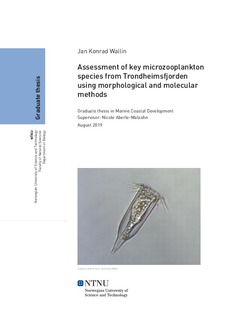| dc.contributor.advisor | Aberle-Malzahn, Nicole | |
| dc.contributor.advisor | Majaneva, Sanna | |
| dc.contributor.advisor | Bading, Katharina | |
| dc.contributor.author | Wallin, Jan Konrad | |
| dc.date.accessioned | 2019-10-31T15:17:41Z | |
| dc.date.available | 2019-10-31T15:17:41Z | |
| dc.date.issued | 2019 | |
| dc.identifier.uri | http://hdl.handle.net/11250/2625854 | |
| dc.description.abstract | Mikrozooplankton (MZP) er heterotrofiske og mixotrofe organismer i størrelsesområdet 20 - 200 µm. Disse organismene er vanskelige å artsbestemme med molekylære identifikasjonsmetoder. Det er mangelfullt med referansedata fra Trondheimsfjorden. Fokus i dette prosjektet var de to viktigste MZP-gruppene, ciliater og dinoflagellater i Trondheimsfjorden. MZP-samfunnet ble overvåket i løpet av en 13 ukers prøvetakingsserie i vår 2019 med fokus på overflod, biomasse og artsmangfold. En topp i MZP-forekomst og biomasse ble observert på juledag 120 med totalt 27160 celler L-1 og 126 ug C L-1. Ciliater dominerer begynnelsen av prøvetakingsserien, mens dinoflagellater øker i antall og biomasse mot slutten. Laboea strobila var den dominante arten når det gjaldt biomasse, og ble karakterisert som en nøkkelart i vårsesongens MZP-samfunn. Den mest artsrike slekten var Protoperidinium med 12 morfologiske arter identifisert. MZP-celler fra Trondheimsfjorden ble isolert i vår-, sommer-, og høstsesongen 2018 for å innhente molekylære data for artsidentifisering. En protokoll for isolasjon av enkeltceller og DNA-amplifisering av MZP-arter fra Trondheimsfjorden ble utviklet. Den endelige protokollen viste en PCR suksessrate på 26,5 prosent. 23 sekvenser ble innhentet og deretter brukt til molekylær identifikasjon av MZP arter. Totalt ble seks sekvenser innhentet for L. strobila fra både 18s og 28s molekylære markører. Selv om viktige MZP-arter ble identifisert ved både morfologiske og molekylære metoder, gjenstår det arbeid for å optimalisere anvendelsen av molekylære metoder for identifikasjon av MZP. | |
| dc.description.abstract | Microzooplankton (MZP) are heterotrophic and mixotrophic organisms in the size range of 20 - 200 µm. The focus in this project was on the two main MZP groups, ciliates and heterotrophic dinoflagellates in Trondheimsfjorden. These groups are difficult to identify morphologically, making them a prime target for molecular identification methods. Molecular reference data for MZP species is scarce, especially from the Norwegian Sea incl. Trondheimsfjorden region. The MZP community was monitored intensively during a 13 weeks sampling series in spring 2019 with focus on species abundance, biomass and diversity. A peak in MZP abundance and biomass was observed in April with total of 27160 cells L-1 and 126 µg C L-1, respectively Ciliates dominated the beginning of the sampling series while dinoflagellates increased in abundance and biomass towards the end. The ciliate Laboea strobila was characterised as a key species in terms of biomass within the spring MZP community in Trondheimsfjorden. The most diverse genus found was Protoperidinium with 12 morphospecies identified. In addition to the intensive spring sampling in 2019, MZP cells from Trondheimsfjorden were isolated during spring, summer and autumn 2018 to obtain molecular data for identification. A working protocol for single-cell isolation and DNA amplification of MZP species from Trondheimsfjorden was developed. The final protocol showed a PCR success rate of 26,5 percent. 23 MZP sequences were obtained and used for molecular identification. In total, six sequences were retrieved for L. strobila from both 18 and 28s molecular markers. Although key MZP species were identified by both morphological and molecular methods, work remains in order to optimise the application and use of molecular methods for MZP identification. | |
| dc.language | eng | |
| dc.publisher | NTNU | |
| dc.title | Assessment of key microzooplankton species from Trondheimsfjorden using morphological and molecular methods | |
| dc.type | Master thesis | |
